How to wash the fat from the kitchen furniture?
Kitchen furniture is most often subjected to various contaminants - during the day there they produce a lot of activities: food processing, cooking various dishes, washing dishes and wet cleaning. The most difficult problem is frozen fat - its small droplets settle on the surfaces of cabinets, on the walls, on the stove. When frozen, they create a sticky crust that quickly collects particles of dirt and dust. To avoid this will not work - even if you have a good hood, you can not exclude oil splashes during frying or drops falling on various coatings by carelessness.

Daily cooking requires at least frequent cleaning in the kitchen
The question of how to wash the fat from the kitchen furniture is always relevant. Remove the frozen crust is a big job, this requires special formulations of aggressive action. The right choice of cleaning agent should provide a quality result and safety for coatings.
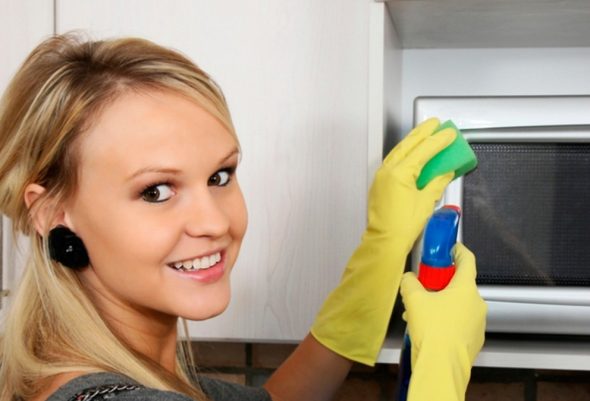
In the case of capricious surfaces that can be scratched with an abrasive, as well as with household appliances, it is better to use liquid detergents
With modern diversity in the field of household chemicals, it is easy to choose a tool that takes into account the characteristics of any surface. Including there are sparing species, excellently coping with pollution on expensive materials. Do not lose the popularity and proven folk recipes cleaning products.

In order for the kitchen to serve for many years, you should choose the right cleaning products.
Content
Application features
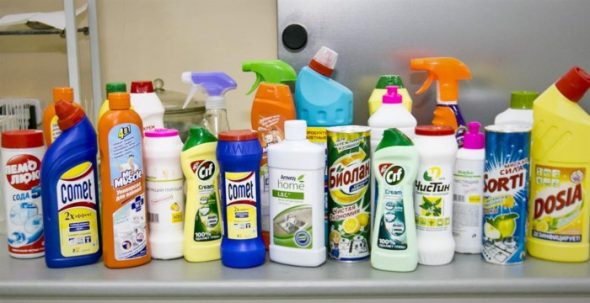
Assortment of kitchen care products
Various types of chemical agents provide many ways to clean kitchen furniture from fat without spending a lot of time and effort. By type of exposure they are divided into several types.
- Powders are convenient for cleaning old contaminants, but due to the aggressiveness of this method of cleaning, the risk of scratching the surface is very high.
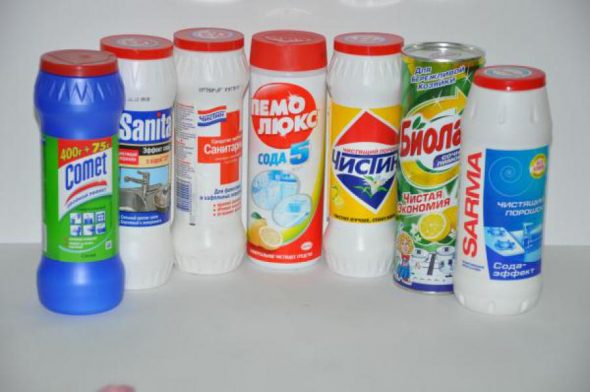
Scouring powders come in various forms and are produced by different manufacturers.
- Liquid solutions, various concentrated gels. This is the widest segment, including soft-acting compounds (for wood or enamel) and strong substances suitable for complex stains, dried oil drops, and soot.
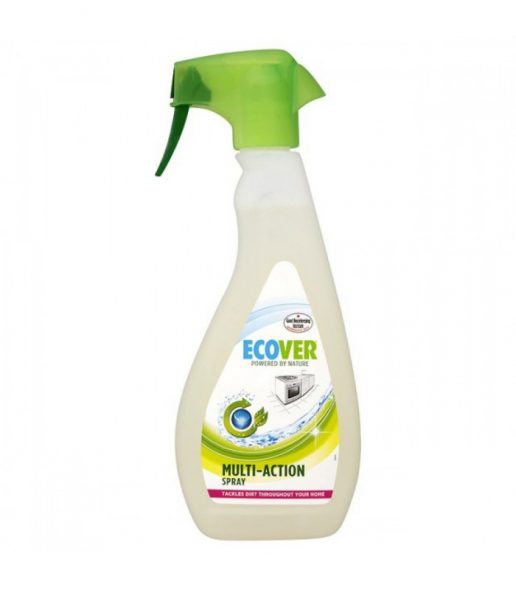
Eco-friendly spray for cleaning any surfaces
- Microgranules pastes, creams - soft universal remedies for all types of coatings.

Kitchen cream washes gently and not aggressively.
- Sprays - well suited for glass and reflective surfaces, the alcohol in the composition ensures rapid evaporation of the substance, the absence of stains.
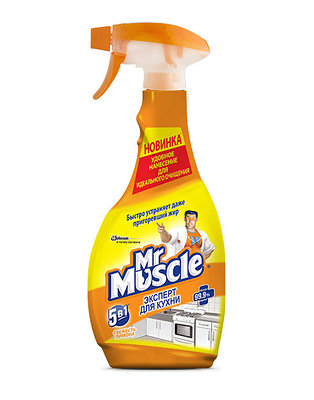
Universal kitchen spray suitable for all surfaces.
- Special sponges of thin flexible wire or melamine, impregnated with chemicals. Sponges are convenient for carrying out fast cleaning, will help to wipe difficult pollution.
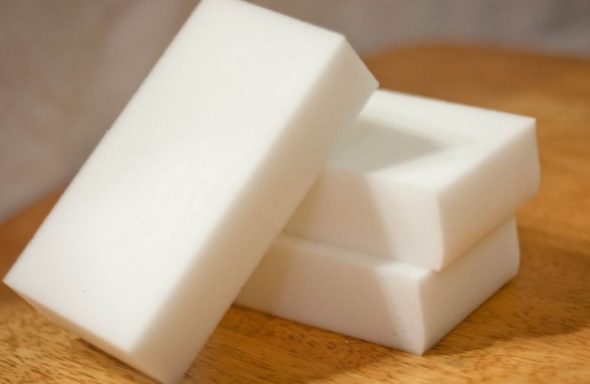
Melamine sponges will clean many surfaces without the use of chemicals
Chemical solutions provide high efficiency, but often represent a danger. Incorrectly chosen composition can damage the expensive material of the kitchen unit, and toxic substances cause poisoning, allergies.For this reason, you should choose household chemicals with great responsibility, and when applying, you must strictly adhere to the instructions and use gloves to protect the skin.
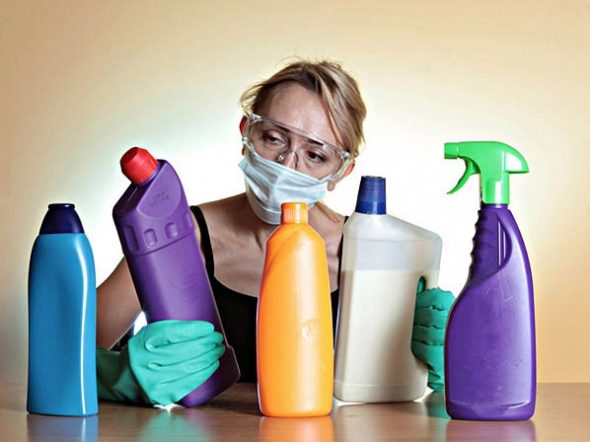
Carefully acquainted with the composition when choosing cleaning products and detergents to avoid allergies
How to wash kitchen furniture from fat. Folk recipes

Simple tools for quick cleaning
Much more benign and less expensive are mixtures based on popular recipes. Their effectiveness and safety has been verified by the experience of entire generations; one should not neglect these simple and effective ways.
- Alcohol with vinegar. The solution will quickly cope with oil stains, disinfect the room. To prepare, mix the alcohol or vodka with vinegar in equal proportions, half diluted with water, the resulting solution is poured into a spray bottle. Grease contamination should be sprayed abundantly, allowed to stand for 10 minutes, wipe with a damp cloth or sponge. For a pleasant aroma in the mixture is enough to drip the essential oil. The alcohol mixture is suitable for delicate cleaning of the furniture set of wood, various household appliances.
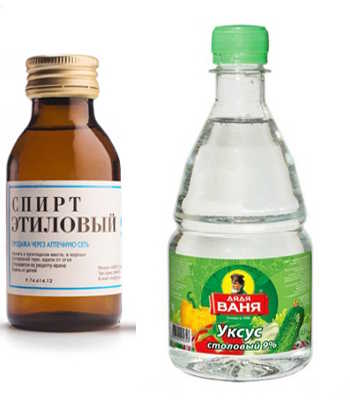
A mixture of alcohol and vinegar for kitchen cleaning
- Baking soda. For best degreasing, it is recommended to use in combination with laundry soap. First, a warm soap solution is prepared (beforehand, the laundry soap needs to be rubbed finely, then it will quickly dissolve in hot water). All polluted places are thoroughly wiped with a sponge moistened in the resulting mixture - the surface must remain wet. Soda is poured onto the sponge, the wiping procedure is repeated. After 20 minutes, the soda along with the remnants of dirt is washed off with warm water. For cleaning wooden cabinets, it is recommended to use baking soda in combination with vegetable oil. They are mixed to obtain the consistency of sour cream, the mixture is applied to the stain, leaving for 15 minutes. It is recommended to rub with a brush or sponge, and wipe the mixture thoroughly with a damp cloth. Baking soda very well cleans the fat in a mixture with hydrogen peroxide - the composition is used to clean the carbon from dishes, baking trays.
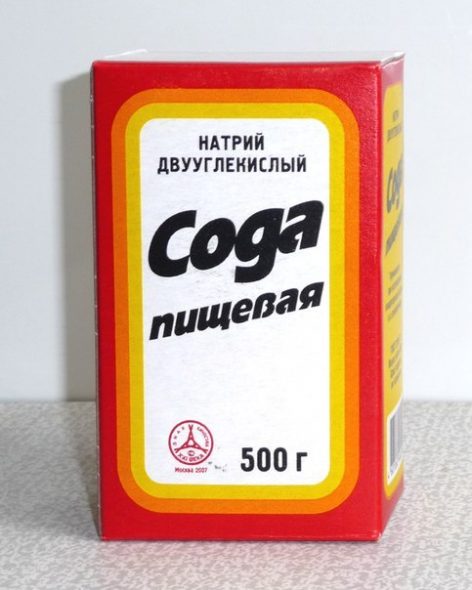
Baking soda in the kitchen is used not only in baking, but also as a safe detergent
- Citric acid - is no less effective tool than industrial acids, while safe for health. The acid is diluted with water and poured into the spray. The desired place is abundantly sprayed, leaving for 15 minutes, wipe with a sponge. Citric acid helps to dissolve the old crust of fat, a layer of soot, soot - for this, it is only slightly diluted with water, stirred to a thick slurry and placed on the problem area.
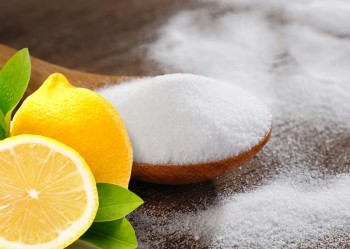
Citric acid is a natural stain remover.
- Sea salt. Copes with oil stains. Salt is stirred with water to a mushy consistency, then lubricate contaminated sites. For abrasive action, use fine powder of salt on a wet sponge.
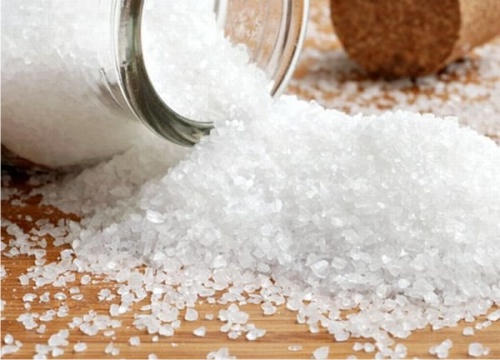
Sea salt is not only a source of beneficial substances and trace elements, but also an excellent means to combat stains.
- Mustard. Apply in the form of powder for rubbing complex stains or diluted with water. Mustard powder is excellent against fatty spots, but will not work with a wooden furniture set.
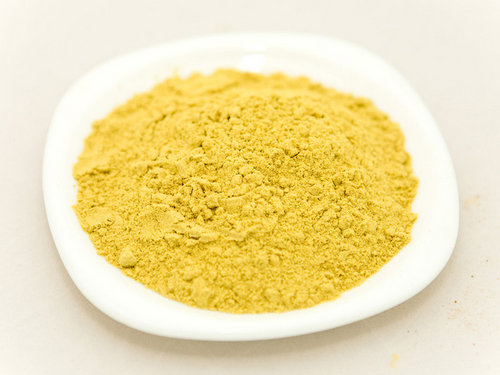
Dry mustard for removing stains
- Ammonia. Its advantage is in fast evaporation, in the absence of streaks on glass, mirror surfaces. To prepare diluted spoon of alcohol in a liter of water, the resulting mixture is poured into a spray bottle. A sponge soaked in solution will be effective. The desired place is sprayed, left for five minutes, wiped with a damp cloth. When using the room should be well ventilated (with the window open, the window).
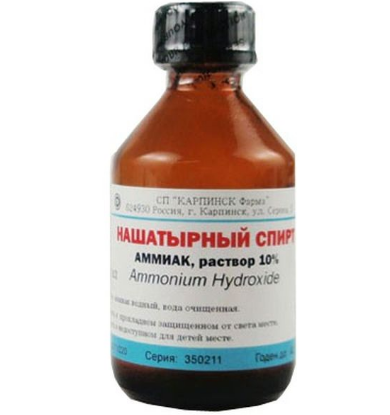
Ammonia - a great helper for cleaning the kitchen and bathroom
- Hydrogen peroxide. Excellent for oil sprays.An additional advantage of peroxide - disinfectant properties. The solution kills bacteria, protecting the room from the appearance of fungus and mold.
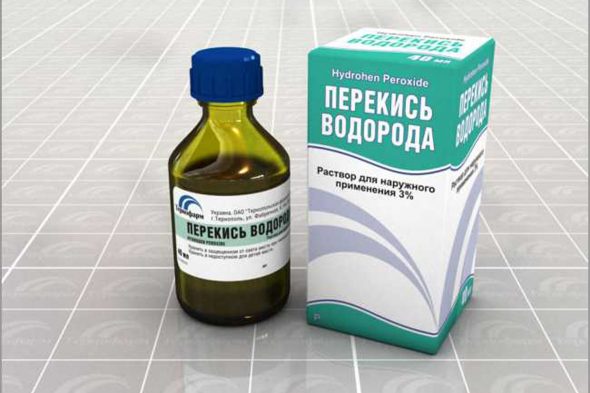
Hydrogen peroxide needs to be kept not only in the first-aid kit, but also in the kitchen
There is a wide variety of recipes for washing the kitchen set of fat using folk remedies, but if the contamination is very old and complicated, household chemicals will be needed that are stronger in effect.
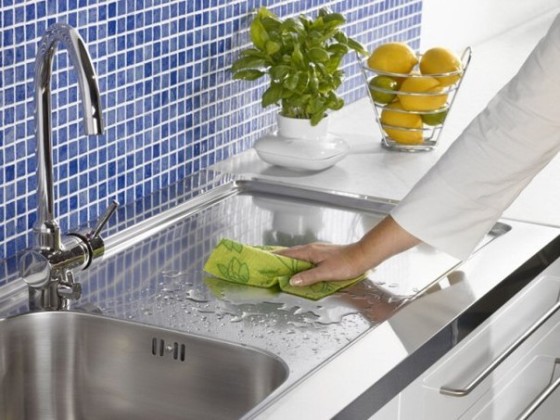
Folk remedies will help to bring perfect cleanliness in the kitchen without any effort and expense.
Cleaning Safety

Keeping the kitchen clean with modern facilities is easy but not always safe.
Qualitatively get rid of the problem spots in the kitchen, without losing time and harm to health will help follow the safety rules.
- You must ensure that the chosen tool fits the material of the kitchen set. Most varieties of household chemicals contain chlorine or acid, which is contraindicated for use on wooden coatings, MDF.
- Abrasive chemistry should be used for metal, ceramics, plastic. It should not be used on varnished or painted surfaces, it is not recommended to take powders for cleaning enamel.
- Do not mix different formulations (apply simultaneously).
- For natural stone (granite or marble) it is necessary to choose specialized tools.
- To reduce the risk of damage to the surface, it is recommended to pre-wet the contaminated area with warm water before applying household chemicals, leaving it for a while. Water will soften the dried crust, eliminating the need to rub the stain with the risk of scratching.
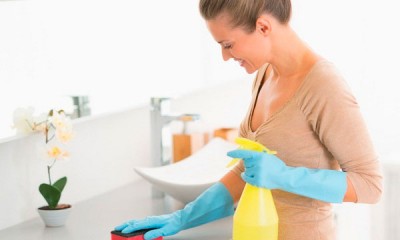
In order to avoid irreparable damage to kitchen furniture, use the tools correctly, according to the instructions.
It is necessary to wear gloves when working with chemical solutions, and if the product is in the open area of the skin, it should be immediately washed off. A number of substances, sprays require the use of masks to protect the respiratory tract.
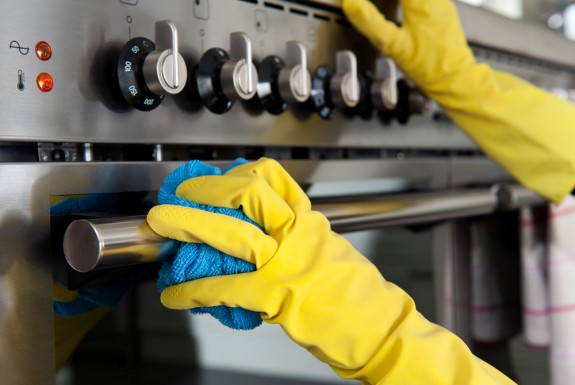
The use of gloves when cleaning surfaces in the kitchen is mandatory
How often do you need to clean the kitchen

Rubbing the furniture in the kitchen every two days, you just need to keep order
The answer to the question “How to clean the kitchen set from fat?” Depends on the type of pollution and the frequency of cleaning. Fresh oil sprays that did not have time to harden are easily removed; to clean, it is enough to wipe the surface with a drop of ordinary dish gel.

Very convenient and efficient kitchen cleaning appliance - steam cleaner
But if the stain had time to harden or wash off the soot with soot, then aggressive cleaning compositions will be needed. To keep efforts to keep clean to a minimum, it is recommended to carry out light preventive cleaning every few days.

We clean the fat in the kitchen from different surfaces, effectively without harm to the surface and our own health
Video: How to clean the kitchen door from fat






